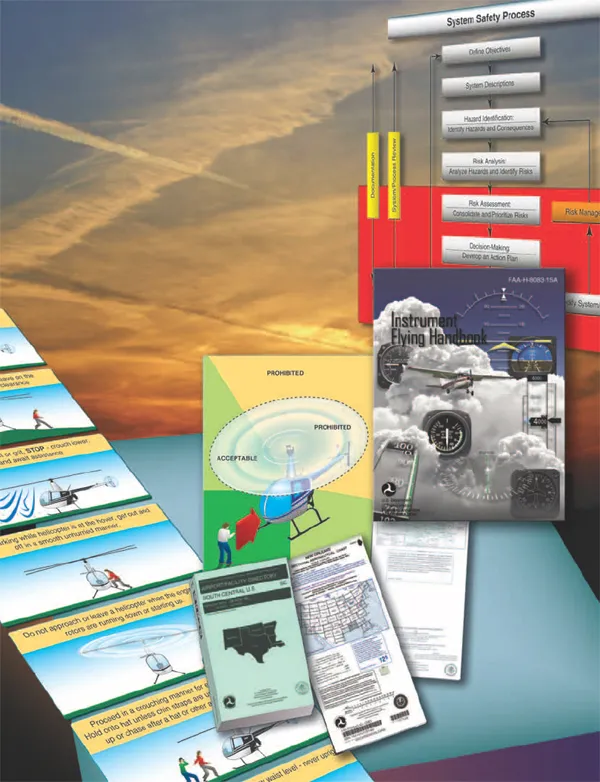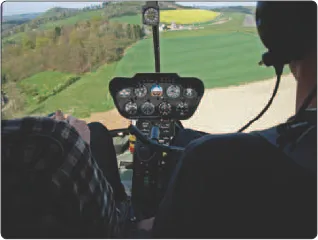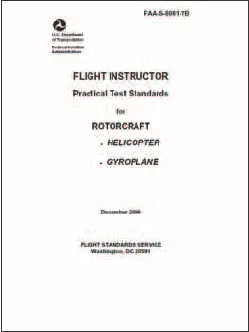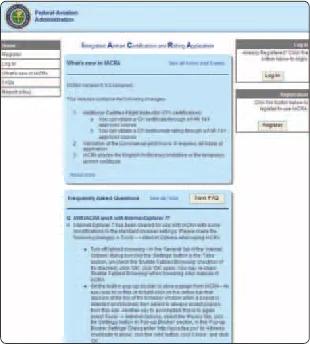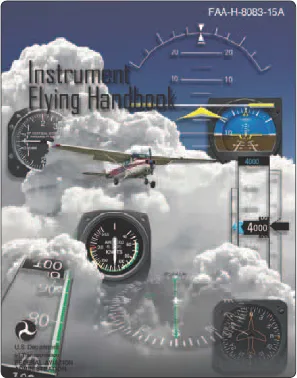![]()
Chapter 1
Introduction to Flight Training
Purpose of Flight Training
It is the helicopter instructor’s responsibility to discuss the overall purpose of flight training with the student. Explain that the goal of flight training is the acquisition and honing of basic airmanship skills that provide the student with:
• An understanding of the principles of flight.
• The ability to safely operate a helicopter with competence and precision both on the ground and in the air.
• The knowledge required to exercise sound judgment when making decisions affecting operational safety and efficiency.
Ensure the student understands that a helicopter operates in a three-dimensional environment and requires specific skills to control the aircraft:
• Coordination—the ability to use the hands and feet together subconsciously and in the proper relationship to produce desired results in the helicopter control.
• Control touch—to develop the ability to sense and evaluate the varying pressures and resistance of the control surfaces and/or the instructor’s input transmitted through the cockpit flight controls and apply inputs in response to those pressures.
• Timing—the application of muscular coordination at the proper instant to make maneuvering flight a constant smooth process.
• Mental comprehension of aerodynamic state, power required versus power available, and hazards present.
Keep in mind that an accomplished pilot demonstrates the ability to assess a situation quickly and accurately and to determine the correct procedure to be followed under the circumstance; to analyze accurately the probable results of a given set of circumstances or of a proposed procedure; to exercise care and due regard for safety; to gauge accurately the performance of the aircraft; and to recognize personal limitations and limitations of the aircraft and avoid approaching the critical points of each. The development of airmanship skills requires effort and dedication on the part of both the student and the flight instructor. It begins with the first training flight when the instructor encourages proper habit formation by introducing and modeling safe operating practices.
While every aircraft has its own particular flight characteristics, the purpose of primary and intermediate flight training is not to learn how to fly a particular make and model of helicopter; it is to develop skills and safe habits that are transferable to any helicopter. [Figure 1-1] Basic airmanship skills serve as a firm foundation for this. Acquiring necessary airmanship skills during training and demonstrating these skills by flying with precision and safe flying habits allows the pilot to transition easily to more complex helicopters. Remember, the goal of flight training is to become a safe and competent pilot, and that passing required tests for pilot certification is only the first step toward this goal.
Practical Flight Instructor Strategies
As discussed in Chapter 8 of the Aviation Instructor Handbook, certificated flight instructors (CFIs) should remember they are a role model for the student. The flight instructor should demonstrate good aviation air sense and practices at all times.
Figure 1-1. As part of flight training, a pilot instructs a student on proper techniques for landing at an airport.
For the helicopter CFI, this means:
• Before the flight—discuss the procedures for the exchange of controls, establish scan areas for clearing the aircraft, and establish who is responsible for initiating immediate action in an emergency.
• During flight—prioritize the tasks of aviating, navigating, and communicating. Instill the importance of “see and avoid” and utilizing aircraft lighting to be more visible in certain flight conditions.
• During landing—conduct stabilized approaches, maintain proper angle and desired rate of closure on final. Use aeronautical decision-making (ADM) to demonstrate good judgment for go-arounds, wake turbulence avoidance, traffic, and terrain avoidance.
• Always—remember that safety is paramount.
Flight instructors have the responsibility of producing the safest pilots possible. For that reason, CFIs should tirelessly encourage each student to learn as much as he or she is capable of and keep raising the bar toward the ultimate goal. When introducing lesson tasks, flight instructors should introduce the student to the Practical Test Standards (PTS) and discuss that the minimum acceptable standards for passing a given maneuver are stated therein. The CFI must stress to the student that these are only the minimum standards and that he or she should strive for much higher performance.
The PTS is not a teaching tool. It is a testing tool. The overall focus of flight training should be on learning, which includes gaining an understanding of why the standards exist and how they were determined. [Figure 1-2] Use the PTS as a training aid. Title 14 of the Code of Federal Regulations (14 CFR) does require specific training for the PTS endorsements, but this should not be presented to the student at the end of the training. The CFI should take into consideration all of the necessary training and strategically plan that training so the student has time to practice and prepare. It is the ultimate goal of the CFI to produce the safest, most competent pilot from his or her course of instruction and take pride in knowing that the student not only passed the test standards but exceeds those standards when conducting any and all helicopter procedures, on the ground or in the air.
Figure 1-2. Practical Test Standards.
The Federal Aviation Administration (FAA)
Role
It is imperative that a new student be introduced and become familiar with the role of the Federal Aviation Administration (FAA) in aviation. For the new student, this includes introducing him or her to the parts and subparts of 14 CFR that relate to flight training and pilot certification. To be included are pertinent handbooks, the PTS, and any references the CFI determines to be valuable to the student pilot learning experience. For transitioning pilots, the PTS for the helicopter is a key reference. The student should also be introduced to the Knowledge Test Guides that can be found at www.faa.gov.
An online session at the FAA website provides the CFI with an opportunity to introduce the new student and/or transitioning pilot to the many resources now available around the clock. The site has easy-to-access handbooks, regulations, standards, manuals, references, and even online courses. With the advent of the Integrated Airman Certificate and/or Rating Application (IACRA), the FAA can process airman certification documents via the Internet, interfacing with multiple FAA national databases to validate data and verify specific fields. IACRA automatically ensures applicants meet regulatory and policy requirements and forwards the FAA Form 8710-1 application and test results to the FAA Airmen Certification Branch. [Figure 1-3] While many younger students interface easily with the Internet, a CFI trains pilots of all ages. Ensuring the student is comfortable using the FAA’s Internet resources is part of a good training program.
Figure 1-3. IACRA processes applications for airman certification via the Internet and automatically ensures applicants meet regulatory and policy requirements through programming rules and data validation.
FAA Reference Material
The reference materials described below, as revised, can be used by the CFI to assemble a handout for the student. An example of such a handout can be found in Appendix A.
• Pilot’s Handbook of Aeronautical Knowledge (FAA-H-8083-25)—provides essential knowledge for pilots as they progress through pilot training. Useful to beginning pilots, as well as those pursuing more advanced certificates.
• Helicopter Flying Handbook (FAA-H-8083-21)—designed as a technical manual for applicants who are preparing for their private, commercial, or flight instructor pilot certificates with a helicopter class rating. The handbook contains detailed coverage of aerodynamics, flight controls, systems, performance, flight maneuvers, emergencies, and ADM specific to helicopter flight, which makes it a valuable training aid. Helicopters are rotorcraft as are gyroplanes. Gyroplanes and helicopters are the two classes of aircraft in the rotorcraft category. Therefore, to differentiate between the classes of aircraft with different skill requirements, the FAA issues rotorcraft helicopter ratings or rotorcraft gyroplane ratings.
• Instrument Flying Handbook (FAA-H-8083-15)—designed for use by instrument flight instructors and pilots preparing for instrument rating tests, this handbook is a valuable training aid for CFIs as it includes basic reference material for knowledge testing and instrument flight training. [Figure 1-4]
Figure 1-4. The Instrument Flying Handbook is one of many training aids provided by the FAA Airman Testing Standards Branch.
• Risk Management Handbook (FAA-H-8083-2)—provides tools to help pilots determine and assess each situation for the safest possible flight with the least amount of risk. This handbook presents methods pilots can use to manage the workloads associated with each phase of flight, resulting in a safer, more enjoyable, and less stressful experience for both themselves and their passengers.
• Advanced Avionics Handbook (FAA-H-8083-6)—provides general aviation users with comprehensive information on the advanced avionics equipment available in technically advanced aircraft.
• Aeronautical Information Manual (AIM)—Chapter 10 of the AIM includes items that specifically pertain to helicopter operations. The AIM also provides the aviation community with basic flight information and Air Traffic Control (ATC) procedures for use in the National Air Space (NAS) of the United States. It also contains items of interest to pilots concerning health/ medical facts, factors affecting flight safety, etc.
• Airport/Facility Directory—containing information on public and joint use airports, communications, navigation aids, instrument landing systems, very high frequency (VHF) omnirange navigation system (VOR) receiver checkpoints, preferred routes, Automated Flight Service Station (AFSS)/Weather Service telephone numbers, Air Route Traffic Control Center (ARTCC) frequencies, part-time surface areas, and various other pertinent special notices essential to air navigation, the directory is now available in digital format at www.faa.gov.
• Practical Test Standards—the Rotorcraft (Helicopter and Gyroplane) PTS establishes the standards for pilot certification practical tests for the rotorcraft category, helicopter, and gyroplane classes. FAA inspectors and designated pilot examiners (DPEs) conduct practical tests in compliance with these standards. Flight instructors and applicants should find these standards helpful during training and when preparing for the practical test. More detailed information can be found at www.faa.gov. Refer the new student to page 3 of the PTS which provides a list of references used to compile the standards under which he or she is tested. This list identifies the publications that describe the various tasks that need to be mastered prior to the test. While explaining the PTS, be sure to review the Rotorcraft Practical Test Prerequisites.
An applicant for the Rotorcraft Practical Test is required by 14 CFR part 61 to:
1. Be able to read, speak, write, and understand the English language. (If there is a doubt, use Advisory Circular (AC) 60-28, English Language Skill Standards.)
2. Have passed the appropriate pilot knowledge test since the beginning of the 24th month before the month in which the practical test is completed.
3. Have satisfactorily accomplished the required training and obtained the aeronautical experience prescribed.
4. Possess a current Medical Certificate.
5. Have an endorsement from an authorized instructor certifying that the applicant has received and logged training time within 60 days preceding the date of application.
6. Also have an endorsement certifying that the applicant has demonstrated satisfactory knowledge of the subject areas in which the applicant was deficient on the airman knowledge test.
Role of the Examiner
The subject of the PTS also offers the CFI an opportunity to discuss the role of the examiner who plays an important role in the FAA’s mission of promoting aviation safety by administering FAA practical tests for pilot and flight instructor certificates and associated ratings. To satisfy the need for pilot testing and certification services, the FAA delegates certain of these responsibilities to private individuals who are not FAA employees.
Appointed in accordan...

